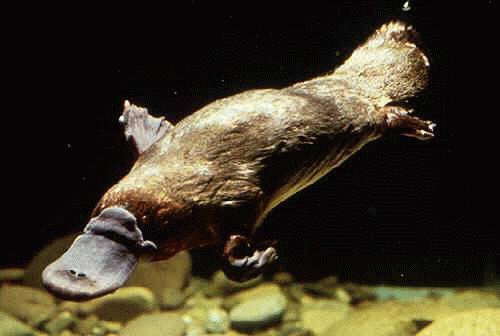
[The
platypus: Still more questions than answers for evolutionists by
Paula Weston]

Imagine, if you will, the excited glances exchanged if paleontologists were to uncover a fossil that looked like a mammal, yet also had bird and reptilian features. The immediate reaction would probably be to declare that here was, clearly, a transitional creature that provided an evolutionary link between mammals and their non-mammalian ancestors.
That might well be the conclusion drawn if a platypus fossil were found today, without living examples around to indicate otherwise.
The platypus has perplexed scientists since its discovery by Europeans in the late 18th century. Here is a creature that has a furry body like most mammals, webbed feet and a bill like a duck, and a reproductive system that involves young being hatched from eggs before suckling from their mothers.
In fact, when the first platypus specimen reached England in 1799 (it was long dead), it was regarded as a hoax, a ‘high frolic practised on the scientific community by some colonial prankster’.1 Experts of the day could not reconcile the fact that a duck-billed mammal with webbed feet and claws and a beaver-like tail could really exist. One zoologist, sure it was fraudulent, tried to remove the ‘duck’s bill’ from the pelt; his scissor-marks can still be seen on the original, in London’s British Museum of Natural History.
The creature was ultimately deemed to be genuine, but it took another 90 years of long and arduous investigation and experimentation before scientists had a better understanding of its complexities.
The platypus and the echidna (only found alive in Australia) are the only known monotremes—mammals that lay reptile-like eggs and suckle their young. But, even when suckling, they are not like other mammals; the milk is not produced through teats, but is apparently sucked from the skin as it exudes from the ducts of the mammary glands.2
In its natural habitat—lakes and streams in eastern Australia and Tasmania—the platypus reveals an amazing array of design features. It uses claws for burrowing and its webbed feet for swimming (the web, which extends beyond the claws, is folded under the palms when the platypus is on land), while its broad, flat tail helps with diving.2 Fine fur, made up of 900 hairs covering each square millimetre of skin has two layers—a woolly undercoat and shiny longer hair—that keep most of the platypus’s body dry when diving.3
The platypus often swims along the surface, with only the upper part of the muzzle and a small part of the head above water. When it submerges, it has a fold of skin that closes over its eyes and ears.2 Its duck-like bill is actually a sensitive muzzle that allows the platypus to find tiny food morsels at the bottom of murky lakes and rivers and under rocks using highly developed electro-receptors (see aside below).
For more than 100 years, debate has raged within the scientific community about various aspects of the platypus, muted only briefly and very occasionally by (very infrequent) new discoveries (such as the proof in 1884 that the creature laid eggs, rather than gave birth to live young).4
Of particular interest has been the creature’s origin. Encyclopaedia Britannica says that ‘little is known of their ancestry’ and: ‘Most authorities believe the order Monotremata originated from a line of mammal-like reptiles different from that which gave rise to the other mammals. Nonetheless monotremes may well represent features of anatomy and development that characterized the earliest mainstream mammals.’5
Scientists initially considered the platypus to be ‘primitive’, but then they discovered the incredibly complex electrolocation techniques the animal uses to find food. To evolutionists this made it a ‘highly evolved animal and not a primitive transition between reptiles and mammals.’6
The platypus, along with its fellow monotreme, the echidna, was believed to have evolved in isolation when the land mass that would become Australia (Gondwana) broke away from the other continents supposedly 225 million years ago.7 This idea of evolution in isolation followed the theory of Darwin, whose affinity for evolution may also have been influenced by his early studies of the platypus during his time on The Beagle.8
However, the discovery in the early 1990s of three platypus teeth in South America—almost identical to fossil platypus teeth found in Australia—threw that theory upside down.9 (Marsupials, too, were once considered to be exclusive to Australia, but their fossils have now been found on every continent.) Adult living platypuses do not have teeth, but the discovery of platypus fossils in Australia had already identified that their ancestors did have teeth, which were unique and distinctive.10 http://www.answersingenesis.org/articles/cm/v24/n2/platypus